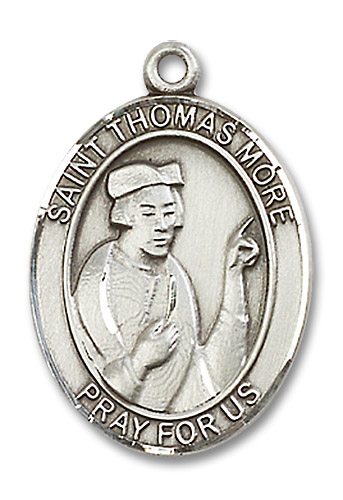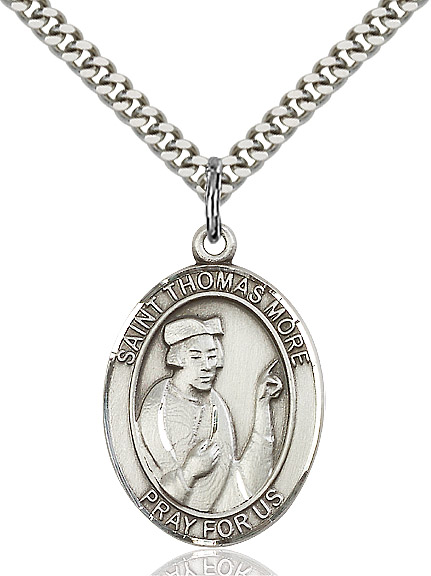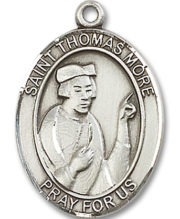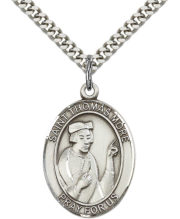$58.99 – $1,254.00
St. Thomas More Medal
- St. Thomas More is the patron saint of civil servants, court workers, lawyers and widowers.
- St. Thomas More’s feast day is celebrated on June 22nd.
This St. Thomas More medal has been proudly hand-made for over a century by Bliss’ team of artists in Rhode Island. The St. Thomas More medal is crafted to last a lifetime.
St. Thomas More Medal
This St. Thomas More Medal and Necklace features a pendant with a hand pressed image of St. Thomas More surrounded by the words ‘St. Thomas More Pray for Us’.
Sterling Silver St. Thomas More Medal and Necklace
14KT Gold Filled St. Thomas More Medal and Necklace
14KT Gold St Thomas More Medal
Saint Thomas More, born in London in 1480, was the son Sir John More, one of the Judges of the King’s Bench was sent to one of the best schools then existing in London. At the age of fourteen he became a page in the household of Cardinal Morton, Archbishop of Canterbury. Two years later, on the advice of the Cardinal, More was sent to Oxford, where he remained two years. He was not eighteen years old and began the study of law at the Inn of Court of London.
Holy Marriages
Strongly disposed to embrace a religious life, the famous Dean Colt, his director, advised that to be a layman and a married man was best for him. More was twice married, first, at the age of 23 or 24 to the daughter of an Essex gentleman, Colt of New Hall. This first union brought him happiness , but it was not of long duration. His wife bore him three daughterters and a son, and died about six years after their marriage.
Two or three years later, he married a widow, seven years his senior, to govern his house and bring up his children. She was an attentive and thrifty housewife and was kind to the children, but she was hard, narrow and worldly, and never comprehended More’s character, which was considerably above and beyond her. Consequently, she became an adversary instead of a consolation to him in his last great trial. At the age of 24, More became a member of the House of Commons and distinguished himself by his opposition to the executions of King Henry VII.
Service to king Henry VIII
In 1509, when More was twenty-nine, Henry VII died, and his son Henry VIII, then a youth of eighteen, succeeded. More won high favor with Henry VIII and the King’s great minister, Cardinal Wolsey. Both appreciated his tailent and qualities. He was made successively, and without his own seeking, a knight, a Privy Councillor, Treasurer of Exchequer, and Chancellor of the Duchy of Lancaster. When Wolsey was deprived of the Great Seals and was wished to his diocese of York, Sir Thomas More replaced him in 1529, when he was 49 years of age. More was the first layman who, for a considerable period, had been raised to that dignity. He held the Seals for about two and a half years.
The King having lived for nearly twenty years with his excellent and virtuous wife, Catherine of Aragon, fell in love with Anne Boleyn. He sought an annulment of his marriage from the Pope, Clement VII. It was Wolsey’s failure in this matter that caused his downfall. The King repeatedly tried to get More to back him, but More firmly refused to do so. When the King offered More the chancellorship, he accepted it only on condition that he would not be asked to take any part in the matter of a divorce. And when it became apparent that the decision of the Holy See would be adverse to the wishes of the King, More had to choose between his conscience as a Catholic and the honors and rewards of this world.
The Great Schism of the Church of England
He supplicated Henry to relieve him from his office of Chancellor. The King, with reluctance, accepted his resignation in 1532. More was then 52 years of age. Henry VIII summoned him to be present at his public marriage with Anne Boleyn. More refused, and earned the implacable hatred of both. Henry had now determined to sever himself wholly from the jurisdiction of the Pope, and to declare himself sole head of the Church of England.
This was, of course, complete and absolute schism, a total separation from the body of the Catholic Church. The oath of supremacy was tendered to the clergy, who freely took it, but as yet it had not been tendered to any layman. It was resolved to begin with Sir Thomas More, in the expectation that if he did not resist no other would. He refused. A second effort was made to have him sign. Again he refused. There followed his incarceration in the Tower of London, his condemnation to death, and beheading at Tyburn on July 5, 1535. Four hundred years later, in 1935, he was numbered among the canonized Saints.
St. Thomas More Rosary
UPC: 617759578218
Brand: Bliss
| Metal Finishing | |
|---|---|
| Size |
Be the first to review “St. Thomas More Medal and Necklace” Cancel reply
You must be logged in to post a review.





Reviews
There are no reviews yet.